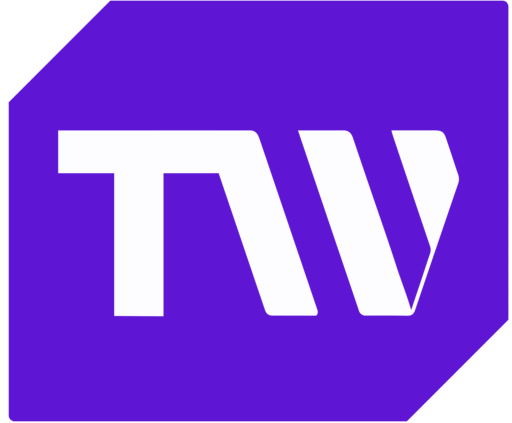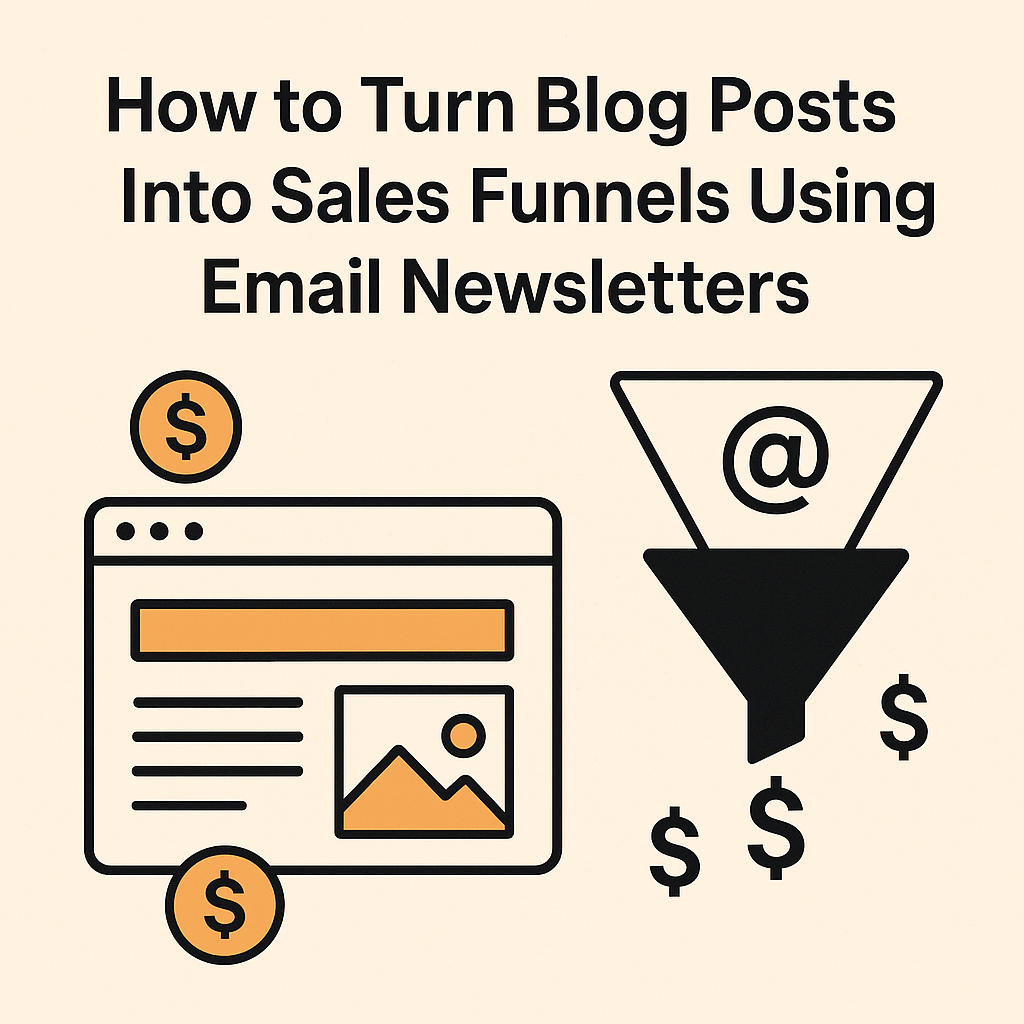How to Turn Blog Posts Into Sales Funnels Using Email Newsletters
Your blog is not just a publishing platform; it’s the starting point of a conversion journey for your potential customers. Think of it as your “showroom” where visitors get to see what you can do. By investing in providing high-quality content, adding carefully crafted lead magnets, and a strategic email sequence, you can guide visitors from being strangers to loyal customers.
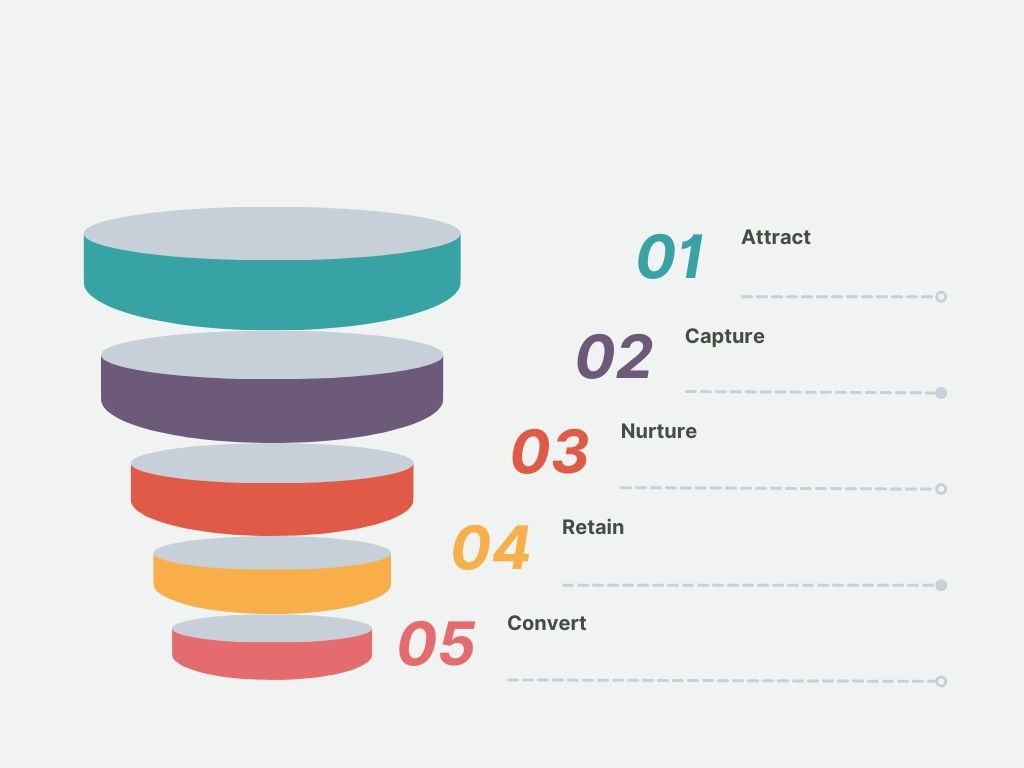
-
Attract: High quality blog posts that are SEO optimized.
-
Capture: Strategic call-to-action (CTA) placements and compelling lead magnets that convert visitors into email subscribers.
-
Nurture: Automated, personalized email sequences that build trust, educate, and warm up leads.
-
Convert & Retain: Targeted offers and post-purchase emails that drive conversions and encourage repeat business.
So, whether you are a business owner, marketing lead, content manager, or you are just looking to generate leads, this piece is for you. In it, I will explain clearly how you can go from “reads’ to ‘leads’ in a short time.
What is an Email Sales Funnel?
Let’s start by defining what an email sales funnel is. It is a carefully designed content-driven system that begins with lead capture (via blog posts) and continues with targeted emails that guide potential customers through each stage of their journey, ultimately encouraging them to take the desired action or make a purchase. This approach nurtures leads and builds relationships, turning prospects into paying customers.
Benefits of Using an Email Sales Funnel
There are several perks of using an email sales funnel, some of these are;
-
- Increased Conversion Rates: By guiding prospects through the customer journey, email funnels can significantly boost conversion rates.
-
- Improved Customer Relationships:Nurturing leads and building relationships with them can lead to stronger customer loyalty.
-
- Targeted Messaging: Tailoring emails to specific stages of the customer journey ensures that the right message is delivered at the right time.
-
- Measurable Results: Email funnels allow you to track key metrics like open rates, click-through rates, and conversion rates, providing valuable insights into what’s working and what needs improvement.
How It Works: Key Components
Below, I share a more detailed explanation using the key components of an email sales funnel:
-
- Lead Generation: The first step is to attract potential customers and capture their email addresses through various methods like the blog, landing pages, opt-in forms, or even a free resource.
- Nurturing: Once the leads have been gathered, the next focus is providing valuable content, building trust, and educating prospects about the product or service.
- Conversion: The goal here is to move generated leads down the funnel towards a purchase or desired action, such as signing up for a free trial, making a purchase, or even attending a webinar.
- Retention: At this stage, the funnel aims to retain customers through ongoing communication, loyalty programs, and valuable content, turning them into loyal advocates.
Stages in an Email Sales Funnel
Now that I’ve covered what an email sales funnel is, why it is important, and the key parts that make it work, let’s break it down even further. To clearly understand how leads move from first contact to loyal customer, it helps to look at the five core stages every email sales funnel follows:
-
Awareness: You need to introduce your brand and product/service to potential customers, which is essential, particularly if your product/service is new to the market.
-
Interest: The second stage of an email sales funnel is to create interest in the minds of prospects. You need to provide information that addresses their needs and pain points, explain why your product is unique, and describe what it can do for them.
-
Consideration: At this point, your leads are actively weighing their options. This is where you need to clearly communicate the benefits, differentiators, and unique selling points of your product or service. The goal is to position your offer as the most valuable solution to their problem.
-
Action: The fourth stage is facilitating the purchase or guiding them to take a desired action.
-
Loyalty: You don’t want your customers or readers to stop returning after purchasing your product or using it just once; hence, you need to nurture your relationship with them and encourage repeated patronage.
Now, we’ve successfully established what an email sales funnel is, as well as its benefits, components, and stages. We’ll delve right into how you can turn your blog posts into high-performing sales funnels using email newsletters.
STEP 1: Creating Lead-Magnetic Blog Posts
The first step to this ‘visitor-to-customer’ strategy is creating the kind of content that will naturally attract your target audience, as your blog is more than just a place to share information. It’s a powerful tool for attracting, engaging, and converting readers into leads. You can create posts or content that pull people in by doing the following;
-
Identify High-Value Topics
- Understand your audience: Understanding your audience is key, as this will largely determine the type of content you put out. Imagine that the top consumers of your content are young people with an interest in the tech space, yet you continue to produce content on lifestyle. That’s shooting but missing your mark, therefore it is important you study and understand your audience. Also, you can conduct market research, use surveys, and analyze competitor blogs to pinpoint the real challenges your audience faces.
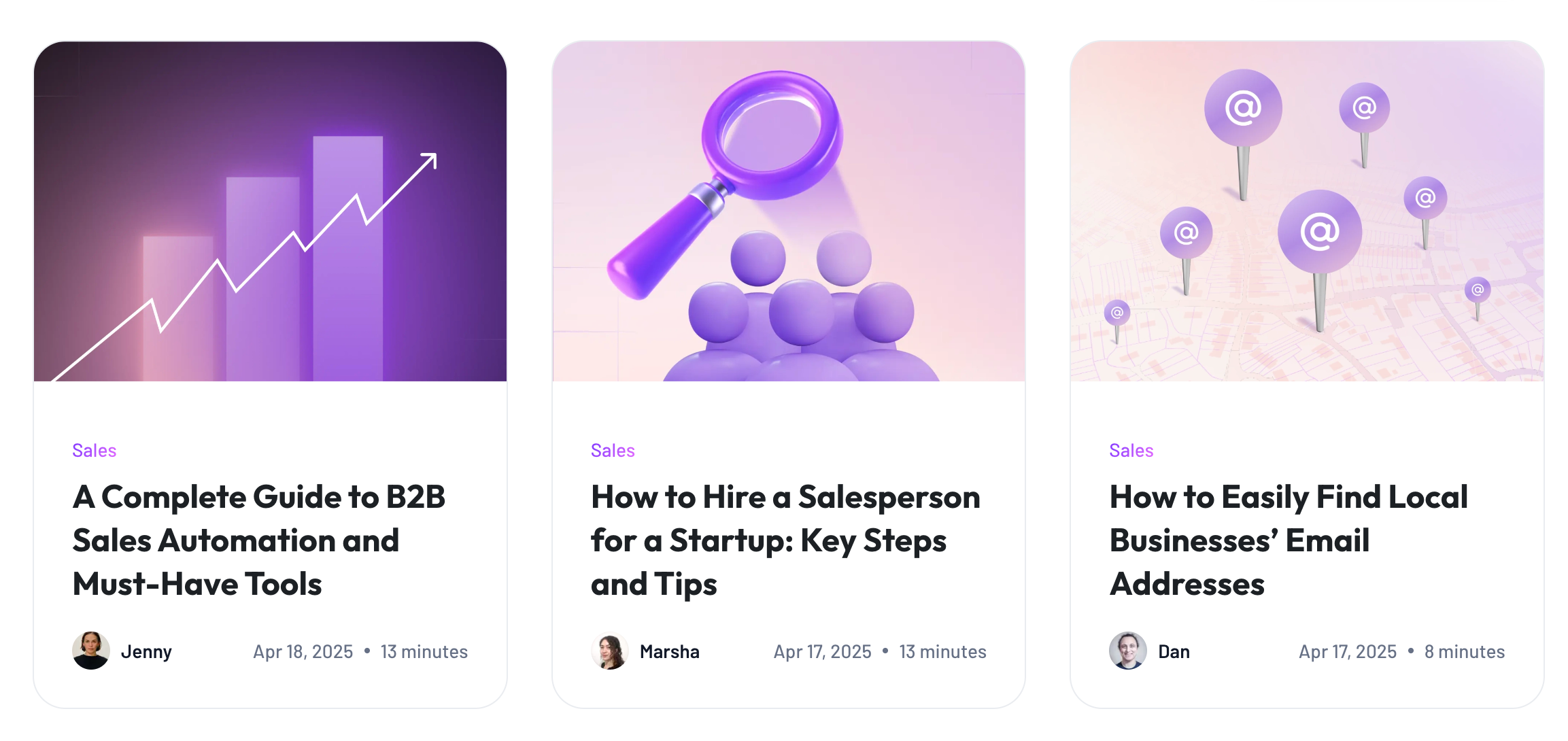
A screenshot of the Artisan AI blog topics
- Do some keyword research: Using the right keywords can bring your content faster to those who are searching for it. You can use tools (like Google Keyword Planner or AnswerThePublic) to identify long-tail keywords that indicate strong intent. For example, if your audience is searching “email sales funnel template for small business,” that signals a clear need.
-
Focus on solutions: Frame your blog posts as guides to problem-solving. For instance, “How to Turn Your Blog into a Lead-Generating Machine” not only educates but primes readers for your email funnel.
-
Optimize Your Content’s Writing and Structure
-
Engage in SEO: Include primary and secondary keywords in titles, headers, meta descriptions, and throughout the content. Other action points include using internal links to other relevant posts and external links to verified sources. These all aid in improving your online visibility, attract organic traffic, build brand awareness, and ultimately drive conversions and sales by ensuring your website ranks higher in search engine results.
-
Employ a User-Friendly Format: Break your content into clear subheadings, bullet points, and concise paragraphs to enhance readability. Support your message with engaging visuals like images, infographics, or short videos to keep readers interested and reinforce key ideas.
-
Call-to-Action Integration: Embed clear CTAs at the beginning, middle, and end of your blog post to guide readers toward your lead magnet. Strategic placement ensures you’re capturing interest at every stage of their reading journey.
You can use compelling language that promises further value, such as “Download Your Free Funnel Template” or “Join Our Exclusive Webinar on Sales Funnels.”
Step 2: Designing Your Blog for Lead Generation
Your blog design plays a critical role in converting visitors into subscribers. It’s not just about great content; it’s about how that content is presented. Strategic placement of Calls-to-Action (CTAs) and a clean, responsive design ensure that your lead generation efforts work seamlessly. Below, I expand on some key elements:
-
Strategic Placement of CTAs
Header & Footer:
-
Always-On Visibility:
You can place opt-in buttons or mini signup forms in both the header and footer of your blog. This approach ensures that regardless of where visitors are on your page, they always have a clear opportunity to subscribe.
The header is typically the first element a visitor sees, making it ideal for a prominent, attention-grabbing CTA. Conversely, the footer acts as a final reminder, capturing users who have scrolled through your entire post.
-
Consistent Branding:
Ensure that you use the same color scheme, fonts, and messaging in these areas to reinforce your brand identity. A consistent look helps build trust and makes the process of subscribing feel like a natural part of the browsing experience.
Sidebar Widgets:
-
Highlighting Your Lead Magnet:
The sidebar is a great spot to feature your lead magnet, whether it’s a downloadable checklist, an exclusive eBook, or a mini-guide. Use visually striking images that catch the eye, paired with bold, concise copy that explains the benefit of your offer.
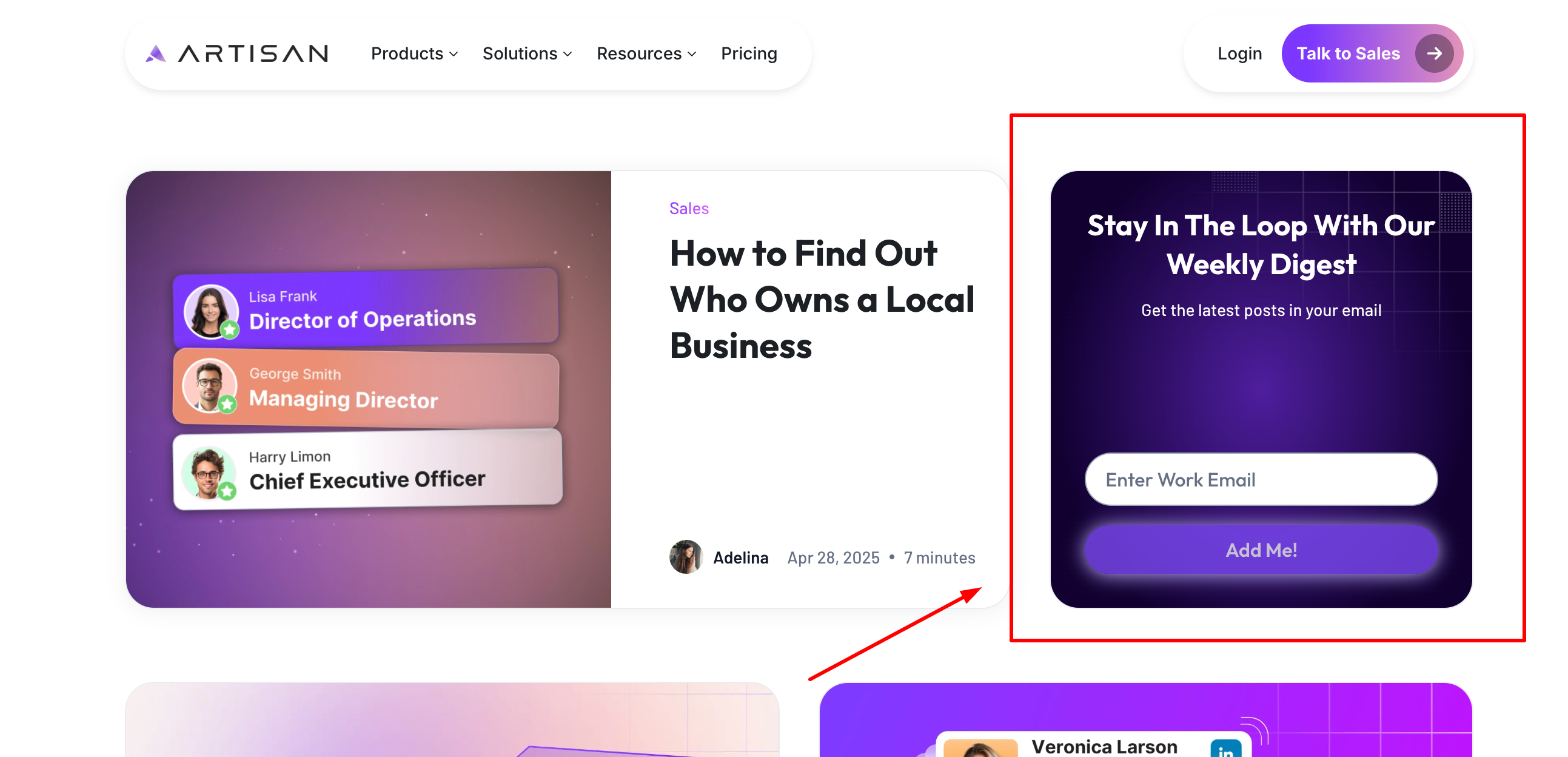
Artisan blog sidebar lead magnet
-
Dynamic Content:
You can consider using widgets that change based on the page or user behavior. For example, if a reader is on a post about email marketing funnels, the sidebar could display a CTA for a related downloadable template. This personalization increases the chances of conversion.
Inline Links and Buttons:
-
Contextual Relevance:
Sprinkle CTAs naturally throughout your content where you address specific pain points or present actionable solutions. For instance, after a section discussing common challenges, include a CTA like “Download our free troubleshooting checklist” to offer immediate value.
-
Content Upgrades:
Enhance your posts with “content upgrades” that are directly related to the topic. These can be downloadable checklists, templates, or mini-guides that provide additional insights. Because they directly complement the content the reader is already engaged with, these upgrades feel like a natural extension of the post, increasing the likelihood of a subscription.
-
User Experience & Design
Responsive Design:
-
Seamless Mobile Experience:
Ensure that your blog and all opt-in forms are optimized for mobile devices. With more users browsing on smartphones and tablets, a responsive design prevents frustrating drop-offs due to poor layout or slow-loading elements. You also need to test your site on multiple devices to guarantee that buttons, forms, and images scale correctly and remain user-friendly.
Visual Hierarchy:
-
Drawing Attention:
Utilize contrasting colors for your CTAs to make them stand out against your background. White space is your friend, as it helps break up content and draws the eye to key elements, such as opt-in forms and buttons.
-
Prioritized Information:
Arrange content in a way that naturally guides the reader through the post. For instance, start with an engaging headline, followed by subheadings that break down the content into digestible sections, and end with a strong CTA. This hierarchy ensures that your lead magnets are seen and understood as a valuable next step.
Minimize Distractions:
-
Focused Design:
Keep your blog design clean and uncluttered. Remove any unnecessary links, sidebars, or pop-ups that do not contribute to your lead generation goal. The fewer distractions there are, the more likely visitors are to focus on your primary CTAs.
-
Streamlined Navigation:
Make sure that navigation is intuitive. A well-organized menu and clear internal links not only improve the user experience but also help guide readers toward relevant content and lead magnets, further reinforcing your conversion strategy.
Pro Tip: You can use a variety of free tools to design your blog, depending on your needs. Here are a few options:
-
WordPress.com or Blogger: Both platforms offer free blog hosting with customizable free themes and basic design features. They’re great if you want an all-in-one solution for writing and designing your blog.
Screenshots of WordPress and Blogger site
-
Wix (Free Plan): Wix provides a drag-and-drop website builder with a free plan, allowing you to design your blog visually without any coding.
-
Canva: If you’re looking to create custom graphics, headers, and social media images to enhance your blog’s design, Canva’s free version offers plenty of templates and design tools.
-
Figma: For more advanced design work, especially if you’re prototyping custom layouts or working collaboratively, Figma offers a robust free plan.
Each tool has its strengths, so you might choose one or a combination to meet all your design needs.
STEP 3: Lead Capture – Turning Visitors into Subscribers
Capturing leads is the essential step in converting passive blog readers into active subscribers. In this stage, your goal is to entice visitors to share their email addresses in exchange for a valuable offer. Let’s dive deeper into the methods and best practices for effective lead capture.
-
Effective Lead Capture Tools
Opt-In Forms and Popups
-
Exit-Intent Popups:
These pop-ups detect when a visitor’s mouse movement suggests they’re about to leave your page. Instead of letting them exit without interacting, exit-intent popups offer a final opportunity to capture their email, perhaps by presenting a limited-time offer or a free resource. -
Best Practices:
-
Use a clear and concise headline that effectively highlights the value of your offer.
-
Include a visually appealing design with contrasting colors to draw attention.
-
Keep the form simple; ask for only the essential details, such as name and email.
-
Test different copy and designs to see what resonates best with your audience.
-
Scroll Boxes and Floating Bars:
As visitors scroll down your blog post, scroll boxes or floating bars appear, reminding them to subscribe. These elements are effective because they are contextually placed, offering the lead magnet when the reader is already engaged with your content. -
Best Practices:
-
Time the appearance of the popup or floating bar so that it doesn’t interrupt the reading experience, typically when a visitor has consumed a significant portion of the content.
-
Ensure the design is non-intrusive yet noticeable, using animation or a subtle slide-in effect.
-
Include a compelling call-to-action (CTA) that ties directly to the value of your lead magnet.
Landing Pages
-
Dedicated Lead Capture Pages:
Sometimes, your blog content might lead readers to a dedicated landing page designed solely to promote your lead magnet. This is particularly useful when driving traffic from external sources like social media or paid ads, where you have limited space to communicate your offer. -
Design Essentials:
-
Keep the landing page focused on a single goal: capturing the email address.
-
Use an attention-grabbing headline that explains the benefit of your lead magnet.
-
Incorporate persuasive copy that emphasizes the value, along with bullet points outlining the key benefits.
-
Use minimal navigation options to reduce distractions and keep the visitor focused on the CTA.
-
Examples:
-
A landing page offering a free eBook on “The Ultimate Email Funnel Blueprint.”
-
A sign-up page for a free webinar series on “Boosting Conversions with Email Marketing.”
Ad: Want a lead magnet that actually works? Let’s create a high-converting eBook for your business.
-
Design & Testing
A/B Testing for Optimization
-
Multiple Designs:
To determine which lead capture design generates the highest conversion rate, it’s important to test various layouts, color schemes, copy, and CTAs. A/B testing lets you compare different versions of your opt-in forms or landing pages.
-
What to Test:
-
Headlines: Try different headlines to see which one grabs attention more effectively.
-
CTA Buttons: Test various button colors, sizes, and text (e.g., “Download Now” vs. “Get Your Free Guide”).
-
Form Length: Experiment with the number of fields required; sometimes asking for only an email works best, while other times, adding a first name can help with personalization later on.
-
Tools with Drag-and-Drop Builders:
Platforms like OptinMonster (or similar alternatives) offer intuitive drag-and-drop builders that let you quickly create and modify your lead capture forms without any coding. These tools are especially useful for non-technical users who need to implement design changes rapidly.
-
Iterative Improvements:
Once you have gathered enough data from your A/B tests, analyze which version of your form or landing page converts the best. Use these insights to further optimize your design. Remember, lead capture is not a one-time setup, continuous testing and refinement are key to maintaining high conversion rates.
By strategically using opt-in forms, pop-ups, and dedicated landing pages, and also, testing and refining these elements, you can create an effective lead capture system that transforms your blog into a powerful subscriber engine. This robust approach ensures that every reader has an opportunity to convert, setting the stage for nurturing and eventually converting them into loyal customers.
STEP 4: Building a High-Converting Email Nurture Sequence
Once you’ve captured a subscriber’s email address, the next critical step is to nurture that relationship. A well-planned email sequence gently guides your subscriber along the sales funnel, transforming a one-time visitor into a loyal customer. Below is a detailed framework for building an effective email nurture sequence.
Stage 1: Welcome & Introduction
Welcome Email
-
Immediate Gratification:
As soon as someone subscribes, send an immediate welcome email. This email should thank the subscriber for joining and then deliver the promised lead magnet (e.g., a downloadable funnel template, exclusive guide, or eBook).
-
Set Clear Expectations:
Clearly explain what type of content they can expect from your emails, whether it’s weekly tips, exclusive strategies, case studies, or special offers. This helps reduce any uncertainty and builds trust from the start.
Personal Touch & Brand Introduction
-
Share Your Story:
Introduce your brand by telling your story. Explain why you’re passionate about solving your audience’s specific problems and share your core values.
-
Humanize Your Brand:
Include a brief personal note from the founder or team member. This helps subscribers feel like they’re part of a community, not just another email list.
Example Email:
Subject: Welcome to [Your Community]! Here’s Your Free Funnel Template
Body:
“Hi [Name],
Thank you for joining our community! We’re excited to share our expertise on turning blog posts into high-converting sales funnels. As promised, please find attached your free email sales funnel template, a tool we’ve used to help our clients boost conversions.
Over the coming weeks, you’ll receive valuable insights, actionable tips, and real-life case studies designed to help you transform your content into a revenue engine.
We’re passionate about solving [specific problems] because we believe in [your brand’s mission]. If you ever have questions, feel free to reply to this email, we’re here to help!
Cheers,
[Your Name/Team Name]”
Stage 2: Value and Education
Educational Content
-
Actionable Tips and How-To Guides:
Follow up with emails that dive deeper into strategies related to your lead magnet. For example, send out a step-by-step guide on creating an effective email funnel, complete with actionable tips that they can implement immediately.
-
Case Studies and Success Stories:
Share real-world examples of how your strategies have helped businesses grow. This provides tangible proof of your expertise and builds credibility.
-
Use of Multimedia:
Incorporate videos, infographics, or even short podcasts to diversify your content. Visual and audio elements can help break up text and make the content more engaging.
Personalization & Segmentation
-
Tailored Messaging:
Segment your email list based on interests or behaviors. For instance, if you have data on which blog posts subscribers are engaged with, send them follow-up emails that are highly relevant to that content.
-
Dynamic Content:
Use personalization tokens (like their first name or company name) and even dynamic content blocks that change based on subscriber preferences.
Example Email:
Subject: How to Build an Email Funnel That Converts – Step-by-Step
Body:
“Hi [Name],
In our last email, we shared your free funnel template. Today, we’re excited to give you a detailed guide on how to build an email funnel that truly converts.
[Include a brief outline of steps with a link to an in-depth blog post or video tutorial]
We know many businesses struggle with [specific pain point]. That’s why we’ve put together this actionable guide to help you overcome those challenges.
Looking forward to hearing your thoughts,
[Your Name/Team Name]”
Stage 3: Building Trust with Social Proof
Testimonials and Case Studies
-
Real-World Evidence:
You can send emails that include testimonials and case studies from satisfied customers. Use concrete data, such as “Our client saw a 30% increase in conversions within 3 months,” to substantiate your claims.
-
Storytelling:
Present these success stories in a narrative format. Describe the challenges your clients faced, the solutions you provided, and the results they achieved. This helps the reader visualize how your strategy can work for them.
Interactive Content
-
Engagement Opportunities:
Encourage subscribers to join live webinars, Q&A sessions, or interactive surveys. These interactions not only personalize their experience but also make them feel valued.
-
Feedback Mechanisms:
Include a short survey or poll asking about their challenges. Use this data to further segment your list and refine your future emails.
Example Email:
Subject: See How [Client Name] Boosted Their Conversions by 30%
Body:
“Hi [Name],
We know that seeing is believing. That’s why we wanted to share a success story from one of our clients. [Client Name] was struggling with [specific challenge] until they implemented our email funnel strategy. Within just 3 months, they saw a remarkable 30% increase in conversions!
[Include a link or embedded video testimonial/case study]
Have questions? Reply to this email or join our upcoming live Q&A session [link]. We’re here to help you succeed!
Cheers,
[Your Name/Team Name]”
Stage 4: Conversion-Encouraging the Final Step
Targeted Offers
-
Clear, Compelling Offers:
Present limited-time offers, discounts, or free trials that directly address the subscriber’s needs. Use persuasive language that communicates urgency (e.g., “Only 3 spots left” or “Offer expires in 24 hours”).
-
Direct Calls-to-Action:
Ensure your CTA is prominent and unambiguous. It should clearly instruct the reader on the next step, whether it’s to purchase a product, sign up for a demo, or join a program.
Overcoming Objections
-
Anticipate and Address Concerns:
Create content that answers common objections. This could be an FAQ section within your email or a myth-busting piece that explains why your solution is the best choice.
-
Provide Additional Assurance:
Offer guarantees, risk-free trials, or customer support assurances to reduce the perceived risk of taking the next step.
Example Email:
Subject: Your Exclusive Offer Await, Only a Few Spots Left!
Body:
“Hi [Name],
We’ve seen incredible success with our [product/service], and we want you to experience it too. For a limited time, we’re offering an exclusive discount/free trial to help you get started.
Here’s what you get:
-
[List key benefits]
-
[Risk-free guarantee or support details]
Don’t miss out, this offer is only available for the next 24 hours. Click the button below to secure your spot now!
[Call-to-Action: Claim Your Offer Now]
If you have any questions or concerns, simply reply to this email. We’re here to help!
Best,
[Your Name/Team Name]”
Stage 5: Post-Conversion & Retention
Onboarding Series
-
Welcome New Customers:
Immediately after a conversion, send an onboarding email that congratulates the customer and guides them on how to get the most out of your product or service.
-
Provide Valuable Resources:
Include usage tips, links to video tutorials, FAQs, and additional resources that help them start strong.
-
Personal Support:
Offer contact details for customer support or invite them to join a community forum where they can ask questions and share experiences.
Retention & Upselling
-
Keep the Conversation Going:
Regularly send personalized recommendations, exclusive offers, and loyalty program details to your customers.
-
Solicit Feedback:
Ask for reviews or feedback about their experience. This not only helps you improve but also reinforces that you value their opinion.
-
Encourage Referrals:
Introduce referral programs that reward customers for spreading the word. This creates a loop that drives new leads into your funnel.
Example Email:
Subject: Welcome to [Your Product], Let’s Get Started!
Body:
“Hi [Name],
Congratulations on joining [Your Product]! We’re thrilled to have you on board. To help you get started, here’s a quick guide that covers everything you need to know:
-
Step 1: [Onboarding tip with link to tutorial]
-
Step 2: [Resource link or FAQ]
-
Step 3: [How to access support/community]
We’re here to ensure you get the most out of our service. If you have any questions, don’t hesitate to reach out. Plus, keep an eye on your inbox for exclusive offers and tips to help you succeed.
Welcome aboard,
[Your Name/Team Name]”
P.S. Love our service? Share your experience with a review and join our referral program to earn rewards!
By following this detailed email nurture sequence, you’ll guide your subscribers smoothly through the entire sales funnel, from the initial welcome to long-term retention. This thoughtful, step-by-step approach not only builds trust and credibility but also maximizes your chances of converting leads into loyal customers.
STEP 5: Analysis, Testing, and Continuous Improvement
Optimizing your blog-to-sales funnel is an ongoing process. It doesn’t stop once you launch your email nurture sequence, you must continuously analyze, test, and refine your strategy to improve conversions and overall performance. Here’s a deep dive into how to do that:
-
Tracking Key Metrics
Website Metrics
Your blog is the entry point to your funnel, so monitoring its performance is critical:
-
Blog Traffic:
You can use tools like Google Analytics to track the number of visitors coming to your blog. Knowing where your traffic originates (organic search, social media, referrals) helps you understand which channels are most effective.
-
Bounce Rate:
The bounce rate indicates the percentage of visitors who leave your site after viewing only one page. A high bounce rate might signal that your content isn’t engaging or that your landing pages aren’t well-optimized. Adjusting content layout, improving load times, or revisiting your call-to-action placements could help reduce this rate. -
Time on Page:
This metric reveals how long visitors are staying on your blog. Longer dwell times suggest that your content is engaging and valuable. Analyze which posts keep readers engaged the longest, and consider replicating their format or topic style in future content.
Email Metrics
Once a visitor subscribes, email performance is the next key area to monitor:
-
Open Rates:
This measures the percentage of recipients who open your email. Low open rates might indicate that your subject lines aren’t compelling enough or that your emails are landing in spam folders. -
Click-Through Rates (CTR):
CTR tells you how many subscribers are clicking on the links within your email. If CTR is low, you may need to rework your email content or call-to-action (CTA) placement to encourage more engagement. -
Conversion Rates:
Ultimately, you want subscribers to take action, whether it’s making a purchase, booking a demo, or signing up for a webinar. Conversion rates measure the percentage of subscribers who complete these desired actions. This metric directly ties to your ROI and overall funnel effectiveness. -
Bounce and Unsubscribe Rates:
Bounce rates reveal issues with deliverability, while high unsubscribe rates may indicate that your content isn’t meeting subscriber expectations. Both metrics provide insight into the health of your email list and content relevance.
Iterative Optimization
Continuous improvement means never settling for “good enough.” Therefore you need to continually use a systematic approach to refine your funnel based on data and feedback:
Feedback Loops
-
Direct Subscriber Feedback:
Occasionally, ask your subscribers for feedback via short surveys or polls. Questions might include: “What topics would you like to learn more about?” or “How can we improve our emails?” This direct insight is invaluable for tailoring your content. -
Behavioral Analysis:
Look at how subscribers interact with your emails and blog posts. Which links get clicked? What content leads to conversions? Use these insights to understand what’s resonating with your audience. -
Customer Support and Sales Team Input:
Gather insights from your support and sales teams who interact with customers daily. They often have firsthand knowledge of recurring questions or objections that can be addressed in your email sequence.
Data-Driven Decisions
-
Metrics Analysis:
Regularly review your key metrics (open rates, CTR, conversion rates, bounce rates). If you notice a dip in performance, for example, a drop in open rates, experiment with new subject lines or test different sending times. Data trends will often signal when a change is needed. -
Iterative Content Tweaks:
Use your A/B testing results to make informed adjustments. For example, if one version of your email outperforms another by a significant margin, roll out the winning variation to your entire list, then continue testing new elements. This iterative process ensures that your funnel evolves with your audience’s preferences. -
Seasonal Adjustments:
Be aware of external factors like holidays, seasonal trends, or industry events that might affect engagement. Adjust your email frequency, content style, and offers accordingly to remain relevant throughout the year.
In Summary
Analysis, testing, and continuous improvement are the backbone of an effective blog-to-sales funnel strategy.
By:
-
Tracking key website and email metrics to understand audience behavior,
-
Establishing feedback loops to gather qualitative insights,
-
And making data-driven decisions for iterative optimization,
You must ensure that your funnel remains dynamic, responsive, and consistently effective in turning readers into loyal customers. This systematic approach not only maximizes your ROI but also helps you stay ahead in the competitive digital landscape.
STEP 6: Common Pitfalls & How to Avoid Them
Even the best email funnels can fall short if common pitfalls aren’t addressed. Below, we dive deeply into the most frequent mistakes we’ve seen and share strategies to avoid them.
-
Inconsistent Content Delivery
Pitfall:
When you don’t have a regular publishing schedule for your blog or email communications, your audience can lose trust or simply forget about you. Inconsistency makes your content feel unreliable, reducing engagement and potentially causing subscribers to disengage or unsubscribe.
How to Avoid It:
-
Establish a Content Calendar:
Create a detailed editorial calendar that outlines when blog posts and email campaigns will be published. This schedule should cover topics, deadlines, and the type of content (educational, promotional, or engagement-focused).
-
Automate Where Possible:
Use automation tools to schedule emails in advance. This helps maintain a consistent delivery even if you have unexpected disruptions.
-
Plan Ahead for Holidays and Special Events:
Build buffers into your schedule to account for holidays or busy periods. Consistent engagement means your audience always knows when to expect new content.
-
Team Coordination:
Ensure that your content creators, editors, and email marketers are aligned on timelines. Regular meetings and updates can keep everyone accountable.
-
Over-Promotion
Pitfall:
Pushing too many sales pitches in every email can quickly turn off your subscribers. When emails are too promotional, readers may feel exploited rather than engaged, leading to higher unsubscribe rates and lower overall engagement.
How to Avoid It:
-
Balance Value with Sales:
Ensure that your emails provide genuine value, such as actionable tips, educational content, or industry insights before including any promotional offers.
-
Use the “80/20 Rule”:
Aim for an 80/20 split where 80% of your content is educational or entertaining, and only 20% is directly promotional.
-
Segment Your Audience:
Tailor your emails based on where subscribers are in your funnel. Early-stage subscribers might prefer more value and less promotion, while warmer leads may be ready for an offer.
-
Soft Calls-to-Action:
Instead of “Buy Now” in every email, use softer CTAs like “Learn More” or “Discover How It Works.” This gently nudges the reader without overwhelming them with a hard sell.
-
Neglecting Mobile Users
Pitfall:
A significant portion of your audience will be accessing your content on mobile devices. If your blog, opt-in forms, landing pages, or emails are not optimized for mobile, it can lead to a poor user experience, increased bounce rates, and lost conversions.
How to Avoid It:
-
Responsive Design:
Choose themes or templates that automatically adjust for different screen sizes. Ensure that images, text, and CTAs are legible and easy to interact with on smartphones and tablets.
-
Mobile Testing:
Regularly test your website and email campaigns on various mobile devices. Tools like BrowserStack or Litmus can help simulate different environments.
-
Simplify Navigation:
For mobile users, keep the navigation intuitive and streamlined. Avoid cluttered layouts that force users to zoom in or scroll horizontally.
-
Touch-Friendly Elements:
Ensure that buttons, links, and forms are large enough to tap easily without accidental clicks.
-
Ignoring Data
Pitfall:
Making assumptions about your audience without backing them up with data is a common error. Without a clear understanding of your audience’s behavior, preferences, and engagement patterns, you risk creating content that doesn’t resonate, leading to subpar performance.
How to Avoid It:
-
Regular Metric Analysis:
Continuously monitor key metrics like open rates, click-through rates (CTR), conversion rates, bounce rates, and unsubscribe rates using analytics tools (e.g., Google Analytics for your blog and ESP analytics for emails).
-
Set Up Dashboards:
Create a custom dashboard that consolidates all critical performance metrics. This makes it easier to spot trends and adjust your strategy quickly.
-
Segment Data by Audience:
Break down your data by demographics, behavior, and funnel stage. This allows you to see which segments are performing well and which need extra attention.
-
Make Data-Driven Adjustments:
Use A/B testing results and metric insights to refine your email content, subject lines, CTAs, and blog topics. For example, if you notice a drop in open rates, experiment with new subject lines or different send times.
-
Not Testing New Ideas
Pitfall:
The digital landscape is constantly evolving, and what worked yesterday might not work tomorrow. Failing to experiment with new ideas can lead to stagnation and missed opportunities for improvement.
How to Avoid It:
-
Implement A/B Testing:
Regularly test different elements of your emails and blog posts, such as subject lines, email copy, CTA placement, images, and design layouts to determine which versions perform best.
-
Experiment with Frequency and Timing:
Vary the send times and frequency of your emails to see if these factors affect engagement. For instance, some audiences might respond better to emails sent on weekends rather than weekdays.
-
Innovate with Content Formats:
Don’t be afraid to try new content formats like video emails, interactive elements (polls, quizzes), or even user-generated content. These can boost engagement and provide fresh insights into what your audience values.
-
Gather Feedback on New Ideas:
Before rolling out major changes, test them with a small segment of your audience or solicit feedback through surveys. This minimizes risk and ensures you’re on the right track.
-
Iterative Approach:
Adopt an iterative mindset where each test is a learning opportunity. Even if an experiment doesn’t yield better results, analyze the data to understand why, and use that insight to inform future tests.
In Conclusion
Your blog can become a powerhouse conversion tool by carefully integrating a high-converting email sales funnel. Start with SEO-rich, value-driven content that addresses your audience’s pain points, then use compelling CTAs and lead magnets to capture emails. Once you have subscribers, nurture them with a personalized, automated email sequence that builds trust, delivers valuable insights, and gradually moves them toward conversion and retention.
This robust, data-driven approach ensures that every blog visitor is given a clear, valuable path toward becoming a loyal customer, maximizing the ROI of both your content and your email marketing efforts.
Credit:
Edwin Eriye, writing support.
